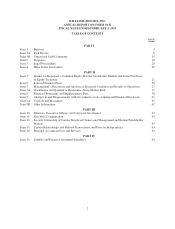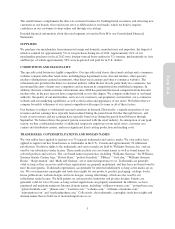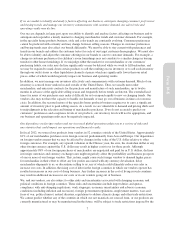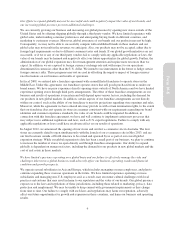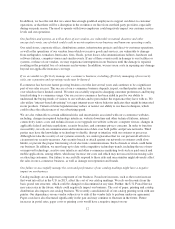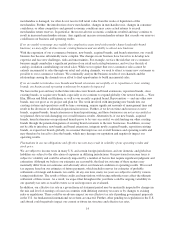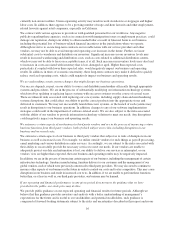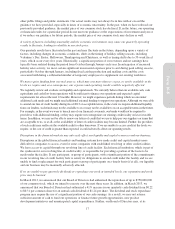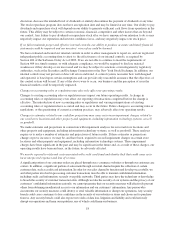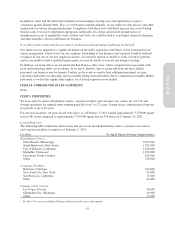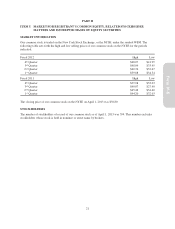Pottery Barn 2012 Annual Report Download - page 25
Download and view the complete annual report
Please find page 25 of the 2012 Pottery Barn annual report below. You can navigate through the pages in the report by either clicking on the pages listed below, or by using the keyword search tool below to find specific information within the annual report.
Our sales may be negatively impacted by increasing competition from companies with brands or products similar
to ours.
The specialty direct-to-customer and retail business is highly competitive. Our e-commerce websites, direct mail
catalogs and specialty retail stores compete with other e-commerce websites, other direct mail catalogs and other
retail stores that market lines of merchandise similar to ours. We compete with national, regional and local
businesses utilizing a similar retail store strategy, as well as traditional furniture stores, department stores and
specialty stores. The substantial sales growth in the direct-to-customer industry within the last decade has
encouraged the entry of many new competitors, new business models, and an increase in competition from
established companies. In addition, the decline in the global economic environment has led to increased
competition from discount retailers selling similar products at reduced prices. The competitive challenges facing
us include:
• anticipating and quickly responding to changing consumer demands or preferences better than our
competitors;
• maintaining favorable brand recognition and achieving customer perception of value;
• effectively marketing and competitively pricing our products to consumers in several diverse market
segments;
• effectively managing and controlling our costs:
• developing innovative, high-quality products in colors and styles that appeal to consumers of varying
age groups, tastes and regions, and in ways that favorably distinguish us from our competitors; and
• effectively managing our supply chain and distribution strategies in order to provide our products to our
consumers on a timely basis and minimize returns, replacements and damaged products.
In light of the many competitive challenges facing us, we may not be able to compete successfully. Increased
competition could reduce our sales and harm our operating results and business.
Our business and operating results may be harmed if we are unable to timely and effectively deliver merchandise
to our stores and customers.
The success of our business depends, in part, on our ability to timely and effectively deliver merchandise to our
stores and customers. We cannot control all of the various factors that might affect our fulfillment rates in direct-
to-customer sales and timely and effective merchandise delivery to our stores. We rely upon third party carriers
for our merchandise shipments and reliable data regarding the timing of those shipments, including shipments to
our customers and to and from all of our stores. In addition, we are heavily dependent upon two carriers for the
delivery of our merchandise to our customers. Accordingly, we are subject to risks, including labor disputes,
union organizing activity, inclement weather, natural disasters, the closure of such carriers’ offices or a reduction
in operational hours due to an economic slowdown, possible acts of terrorism associated with such carriers’
ability to provide delivery services to meet our shipping needs, disruptions or increased fuel costs, and costs
associated with any regulations to address climate change. Failure to deliver merchandise in a timely and
effective manner could damage our reputation and brands. In addition, fuel costs have been volatile and airline
and other transportation companies continue to struggle to operate profitably, which could lead to increased
fulfillment expenses. Any rise in fulfillment costs could negatively affect our business and operating results by
increasing our transportation costs and decreasing the efficiency of our shipments.
Our failure to successfully manage our order-taking and fulfillment operations could have a negative impact on
our business and operating results.
Our direct-to-customer business depends, in part, on our ability to maintain efficient and uninterrupted order-
taking and fulfillment operations in our customer care centers and on our e-commerce websites. Disruptions or
slowdowns in these areas could result from disruptions in telephone or network services, power outages,
inadequate system capacity, system issues, computer viruses, security breaches, human error, changes in
programming, union organizing activity, disruptions in our third party labor contracts, natural disasters or
adverse weather conditions. Industries that are particularly seasonal, such as the home furnishings business, face
a higher risk of harm from operational disruptions during peak sales seasons. These problems could result in a
reduction in sales as well as increased selling, general and administrative expenses.
11
Form 10-K



